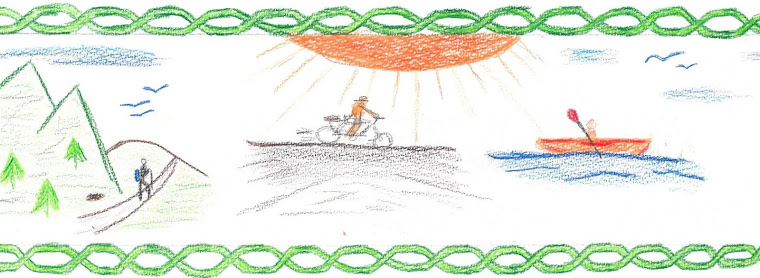I purchased the regular length Marmot Cloudbreak 30, rated to 30 degrees Fahrenheit and weighing less than two pounds, after comparing it to three other similarly priced and designed bags, even climbing into all four and zipping them up around me. I bought it to use when backpacking in wet weather, coastal kayaking, and sleeping aboard a sail boat, all situations where my old three-season down bag might get wet and loose its ability to insulate. After two consecutive nights in temperatures down to 30 degrees Fahrenheit, including rain, sleet, and snow, the second night, I found that the Cloudbreak 30 kept me warm enough if I used the bag liner and dressed properly.
The first night out the temperature dropped to about
45. I wore Patagonia Capilene long
underwear inside the liner bag but no socks and I had not eaten anything for
three or four hours. I awoke during the
night with cold feet and a few other cold spots. The second time the temperature dropped to 30
with rain that turned to sleet that turned to snow. I wore the same Patagonia Capilene long
underwear inside the liner bag but added clean, dry, wool socks and ate some
carbs before turning in. Even though the
temperature was 15 degrees cold that the night before I slept warmer and never
felt any cold spots.
The Cloudbreak 30’s regular length and roomy foot gave my
toes plenty of room to wiggle, especially when they felt cold the first night,
and left enough space for a poly bottle or even a stuff bag of boots if need
be. The girth felt a little constructing
around my upper arms but no more than my old down bag. As others have noted, the zipper can easily
snag, and did a couple of times. Marmot should probably replace it with a
larger tooth zipper.
I have never before used a sleeping back liner but I wanted
one for three reasons, first, to help keep my new Cloudbreak 30 clean, second, to
add extra degrees of warmth, and third, to serve as a summer weight bag when
the Cloudbreak 30 is too warm. The Sea
to Summit Thermolite REACTOP sleeping bag liner, weighing a mere 9 oz, is advertised to increase
warmth by 14 degrees Fahrenheit, hypothetically allowing me to use my Cloudbreak
down to 16 degrees Fahrenheit if I need to while also serving as a standalone
warm weather bag. The REACTOP fulfilled my first two desires during my recent
trip. While the temperature did not drop
below 30, I slept so warmly when it did that I can imagine being nearly as comfortable
at 16 if I dress properly and keep
myself fueled. I am still waiting for a summer night to see if the REACTOP will
fulfill my third desire.
I used to use a full length inflatable Therm-a-Rest pad but
recently misplaced it. Wanting to move toward more lightweight backpacking, I replaced it with the small (20 x 48)
Therm-a-Rest RidgeRest SOlite sleeping pad which weighs a mere 9 oz, far less
than my misplaced Therm-a-Rest, although the SOlite takes up more space than
the inflatable Therm-a-rest when rolled up. I may have felt a few more
irregularities underneath my new SOlite compared to my old inflatable but too
many. I did not miss the old inflatable’s
extra length but I did miss its ability to lay flat when inflated. The SOlightt wanted to curl and partially
roll up if my bag was not lying on top of it.
As a side benefit, the SOlight aluminized surface, advertised to reflect
body heat back toward the body, could also serve in an emergency to help summon
aid or identify location, something my misplaced inflatable would never have
been able to do. I also do not have to
worry about the SOlight being stabbed by an errant branch or tent stake and
losing its insulating ability or comfort.
Taken together, the above sleeping system weighs a little
more than three pounds.
I recently used this sleeping system during a weekend in
late March at over 4,000 feet. As
previously stated, the temperature the first night dropped to about 45. It dropped to 30 the following night as rain
first turned to sleet and then snow. I
woke up the second morning to about three inches of snow.I used the new system in more than ten year old Sierra Designs Ultra Flash 2 person, lightweight, three season. That is right, a three season tent! Even though I was in a three season tent with netting all around, sleeping properly dressed and fueled inside a a REACTOP liner inside a Cloudbreak 30 on top of a short SOlite I slept toasty warm.

No comments:
Post a Comment